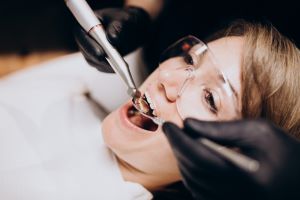 If you’ve got a dental cleaning scheduled, it can help to know what to expect to alleviate any stress you might experience. While many people dread going to the dentist, it might surprise you to know that most dental cleanings are painless and simple. Here are 5 things you can expect during a normal dental cleaning.
If you’ve got a dental cleaning scheduled, it can help to know what to expect to alleviate any stress you might experience. While many people dread going to the dentist, it might surprise you to know that most dental cleanings are painless and simple. Here are 5 things you can expect during a normal dental cleaning.
1. A Physical Examination
Most of the time, a dental hygienist is the person who cleans your teeth, but before starting, they will begin by physically examining your entire mouth. They will use a small mirror to check your teeth for signs of decay and your gums for gingivitis. If necessary, they may call the dentist to look at a potential problem before proceeding.
2. Plaque and Tartar Removal
After the physical examination, your dental hygienist will then use a scaler to remove plaque and tartar around your gum line and between your teeth. While this is happening, you’ll hear scraping sounds, which are completely normal. For many people, this is the worst part of a dental cleaning. If that’s you, remember that brushing and flossing regularly help make this part go more quickly.
3. Gritty Toothpaste
Once your dental hygienist has used the scaler to remove the tartar and plaque from your teeth and gums, they will brush your teeth using gritty toothpaste to help remove any remaining tartar. This toothpaste tastes and smells like regular toothpaste, but the gritty consistency helps to scrub your teeth more deeply than regular toothpaste. It’s safe to use twice a year, but it’s not something you would want to use every day, because it is too hard on your enamel.
4. Professional Flossing
Next, your hygienist will floss your teeth. While you may be diligent with flossing your teeth, the hygienist can give you a professional floss job. This also gives them the opportunity to spot any areas of trouble.
5. Thorough Rinsing and Fluoride Treatment
After flossing, your hygienist will have you rinse your mouth to remove any debris. The rinse usually includes liquid fluoride to help strengthen your teeth and prevent decay. The last step in a dental cleaning is usually a fluoride treatment. This treatment will protect your teeth by fighting decay for several months.
The treatment involves filling a mouthpiece with a foamy gel and fitting it over your teeth for one minute. Then, the hygienist will paint a fluoride varnish onto your teeth with a small brush. This varnish hardens when it comes into contact with your saliva.
Final Thoughts
If you take good care of your teeth and see your dentist regularly, your dental cleaning will be a simple, painless, and fairly quick process.
If it’s time for a dental cleaning or if you have any questions, feel free to contact the office of Dr. Barry H. Buchanan. We’re happy to help you keep your smile bright!
Image: Freepik
